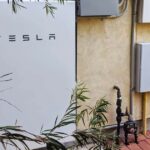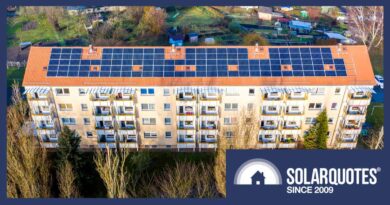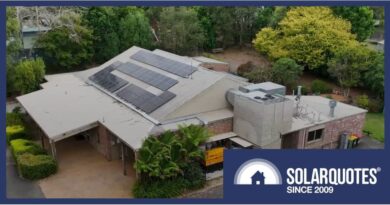Energy Australia’s Solar Plus Plan: Free Solar & Battery Comes At A High Cost

Energy Australia will give you a ‘free’ solar power system + Tesla Powerwall. All you have to do is buy your energy from them for 7 years. Is that a good deal?
TLDR: You’ll save more money if you go to the effort of buying your own, bigger solar power system rather than surrendering your roof’s profits to Energy Australia.
Energy Australia — the nation’s third-largest electricity retailer — has a Virtual Power Plant scheme (VPP) called the Solar Plus Plan. If you meet the requirements and live in the right areas of NSW, Energy Australia will install 5.6 kilowatts of solar and a Tesla Powerwall 2 battery.
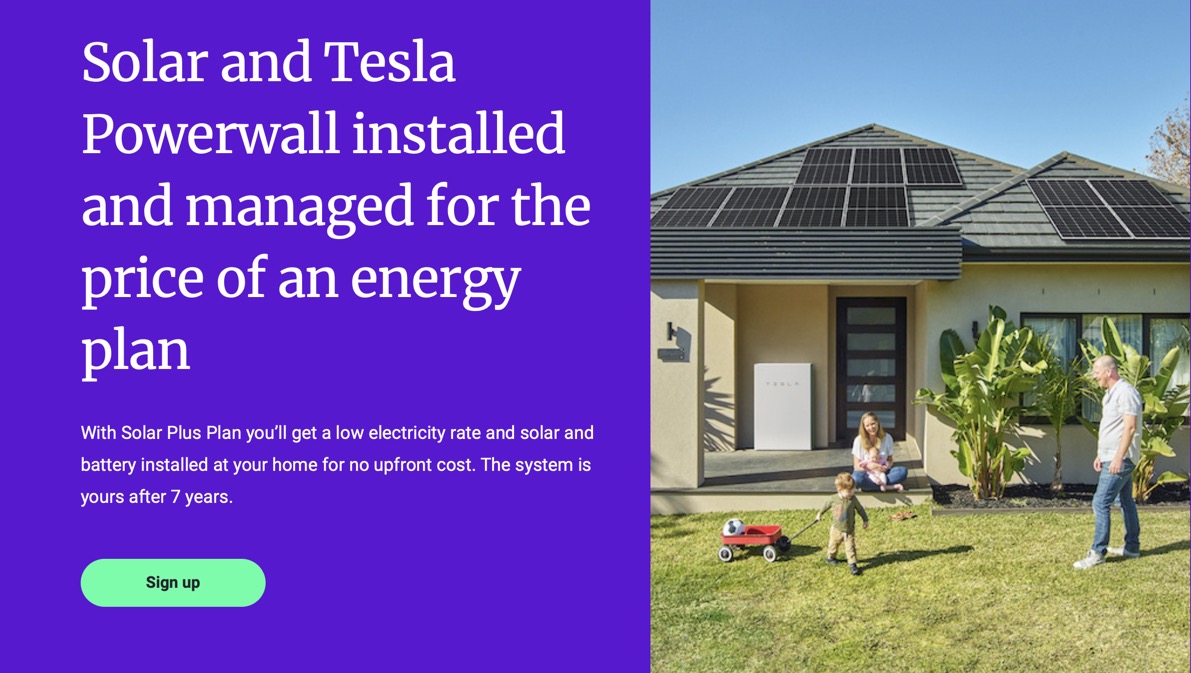
A screenshot from Energy Australia’s website. Note: Don’t even think about putting a Powerwall next to your front door. It’s a stupid place to put it and violates AS/NZS 5139:2019 – Electrical installations – Safety of battery systems for use with power conversion equipment.
If you take Energy Australia up on their offer you will:
- Owe Energy Australia $15,350
- Forgo your solar feed-in tariff for 7 years
- Forfeit any free electricity from the solar power system or the Tesla Powerwall 2 battery for 7 years
- Surrender the freedom to change your electricity plan for 7 years
Which makes it sound as appealing as a romantic evening with Barnaby Joyce.
But the scheme’s selling point is this: you don’t pay the $15,350 upfront.
Instead, you must pay up if you leave the scheme or no longer meet EA’s requirements. The $15,350 is reduced by one-seventh for every full year you remain in the scheme. After seven years, the rooftop solar system and battery become yours and you are set free to do as you will.
As it involves no money down, joining this VPP may appeal to some people, but my advice is to steer clear. By my estimates, you will be better off just buying a solar power system (without a battery) the old fashioned way. By giving the installer some money in exchange for a solar system. Or getting a low rate green loan.
If you want a battery, you can buy one when they come down in price or a different VPP makes a better offer.
Some devious people might be reading this and thinking $15,350 is a pretty good price at the moment for a solar system plus Tesla Powerwall 2. They may consider signing up for the Solar Plus Plan and immediately buying their way out. But there are three reasons why this may not work out:
- It will take 3-5 months to get the solar & battery systems installed, and by then battery prices may have dropped.
- The Powerwall 2 won’t have backup capability configured.
- The 5.6 kilowatt solar power system is smaller than optimal for most homes– especially ones planning to get a home battery.
Unless you want to end up with an inadequately sized solar system and a backup-less battery system at a so-so price, I don’t suggest diving in and then buying out. I don’t suggest diving in at all.
New South Wales Locations
The Solar Plus Plan VPP is only available in certain NSW postcodes. But Energy Australia doesn’t provide a list. What they do instead is let you enter your address on this page and then tell you if it’s available. After entering a dozen or so random NSW addresses, I was told it was available in these postcodes:
- 2065
- 2130
- 2298
- 2232
- 2307
As far as I can tell from my random quizzing, it appears fairly widely available. One of the addresses accepted is in Newcastle, so it’s not just a Sydney thing.
Interestingly, one thing they take into account is whether or not you are near saltwater, so if you live close to the beach, you may be rejected.
Eligibility Requirements
To join the scheme, your home has to meet the following criteria:
- Private residence only and you must have lived there for at least six months
- If you move out, you must pay your way out of the scheme
- You can’t already have solar power or a battery
- You must average at least 10 kilowatt-hours of electricity consumption a day or 12 kilowatt-hours If you have a controlled load1
- You must remain on the required electricity plan
- No one at the address can be on life support
- You can’t have a concession card
- You must pass a credit check
No-Go For Rental Properties
As the Solar Plus Plan is only for private residences, it’s no use to landlords who may want to get a solar & battery system for their property at no cost to themselves. Even if you continue to own the home, if you rent it out Energy Australia says you have to pay the exit fee and leave the scheme.
Q.Maxx Solar Panels Don’t Like Salt
At the moment Energy Australia says they will install the following:

Q.MAXX Solar Panels: The specific panels are Q.MAXX 330 watts. Their installation manual states:

So I presume this is why Energy Australia won’t approve you if you live too close to saltwater. Unfortunately, the manual doesn’t give a distance in metres they must be from the sea.
I consider Q CELLS solar panels to be good quality; although my estimation has gone down a little now I’ve found out their Q.MAX panels are afraid of salt mist. The wording in the manuals for their other panels tends to be different:

But, provided they’re not installed near saltwater, I presume they’ll be fine. Q.MAX panels have a 12-year product warranty. This isn’t bad, but it’s not exceptional these days.
Cheap But Cheerful Goodwe Inverter
5 kW Goodwe Inverter: Goodwe inverters are low cost. I think they’re good value for money and — as far as I am aware — they are one of the most reliable inverters in their price range. But they are not a high priced premium inverter.
Great Battery – If The Backup Worked
Tesla Powerwall 2: The battery will be a Tesla Powerwall 2. When new, it can store 13.5 kilowatt-hours of usable energy and can provide 5 kilowatts of power. Unlike a standard Powerwall 2 installation, it won’t be able to provide backup power during blackouts. No doubt to save on installation costs. So for the first seven years, it will be as useful as a chocolate teapot to the homeowner. I’m surprised Tesla doesn’t mind that people in the scheme will curse Elon Musk as soon as a blackout strikes.
Maintenance & Warranties
Provided a household doesn’t buy their way out of the Solar Plus Plan, Energy Australia will handle all maintenance and repairs for the 7-year length of the scheme. This means you won’t have to pay for the first 5-year inspection of your solar power system, so that may save you a few hundred dollars. The inverter and battery system have a 10-year warranty, so there will be three years left when the scheme ends.2
The VPP May Cause Considerable Battery Wear & Tear
As Energy Australia runs the VPP, they will be able to see exactly how much deterioration the batteries suffer. They will have a very good idea of just how much they can thrash them while still being confident they will remain within warranty. So the Tesla Powerwall battery may have a significant amount of degradation by the end of the seven years, and I don’t think it would be wise to rely on it lasting a long time beyond its 10-year warranty.
Energy Australia Can Alter The Deal In Your Favour
Energy Australia says they can transfer you to a different VPP scheme but only if it is more beneficial to you. If they end the scheme early without transferring you to a different VPP, you will not have to pay the exit fee.
The Solar Power System Is Too Small
On their Solar Plus Plan site, Energy Australia says they will install a 5.6 kilowatt solar system.3 This is strangely small for two reasons:
- A 5 kilowatt inverter will be used, so up to 6.66 kilowatts of solar panels can be installed — provided the inverter manufacturer’s recommendations allow it.
- To get a good return from a battery a home should have over 6.66 kilowatts of solar if at all possible.
Energy Australia may only be installing 5.6 kilowatts of panels in an attempt to lower the system cost. It may also help keep things simple for them by being a convenient size that fits on most roofs. But it means after seven years — or earlier if a participant pays the exit fee — they’ll be stuck with a solar power system that’s too small to regularly charge the Tesla Powerwall 2 battery. On a cloudy winter’s day, a 5.6 kilowatt system in Sydney will often produce less than 6 kilowatt-hours. If the household used half that during the day, it leaves less than 3 kilowatt-hours to store in the battery for use at night. On top of this, the Tesla Powerwall battery efficiency of around 88% will reduce the available stored energy further.
To charge a home battery, I recommend a solar system with more than 6.6 kilowatts of panels.
The Electricity Charge Is Too High
For as long as a household is part of the Energy Australia Solar Plus Plan they will receive no financial benefit from having a solar system or a battery. They will pay the same rate for all their electrical energy, whether it comes from solar panels, battery cells, or the grid. No matter the source, it will all cost 26.5 cents per kilowatt-hour:
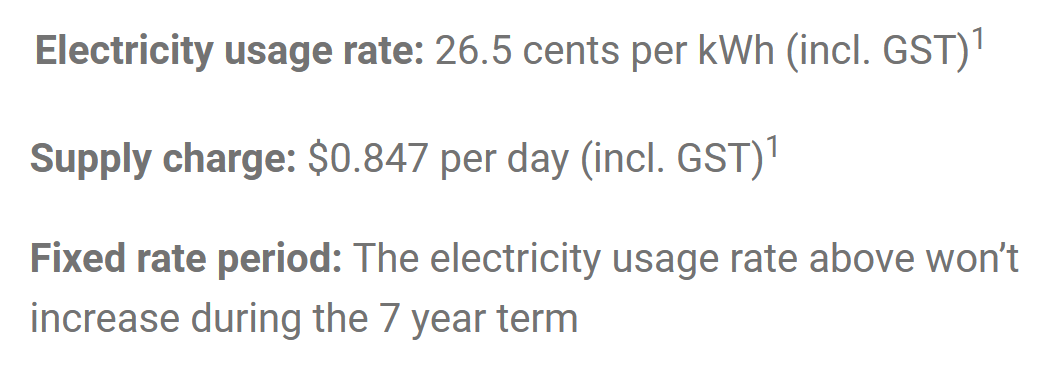
The Solar Plus Plan per-kilowatt-hour charge is fixed and won’t increase over the 7-year term of the scheme, but as electricity prices are trending downwards, this may not help and could result in scheme members paying more than most as time goes by. The daily supply charge of 84.7 cents per day is not fixed and can increase.
While Energy Australia says the rate is less than the current average, if you look around, there are plans as good or even better available now. Here’s a selection I obtained using our Retail Electricity Plan Comparison page:4
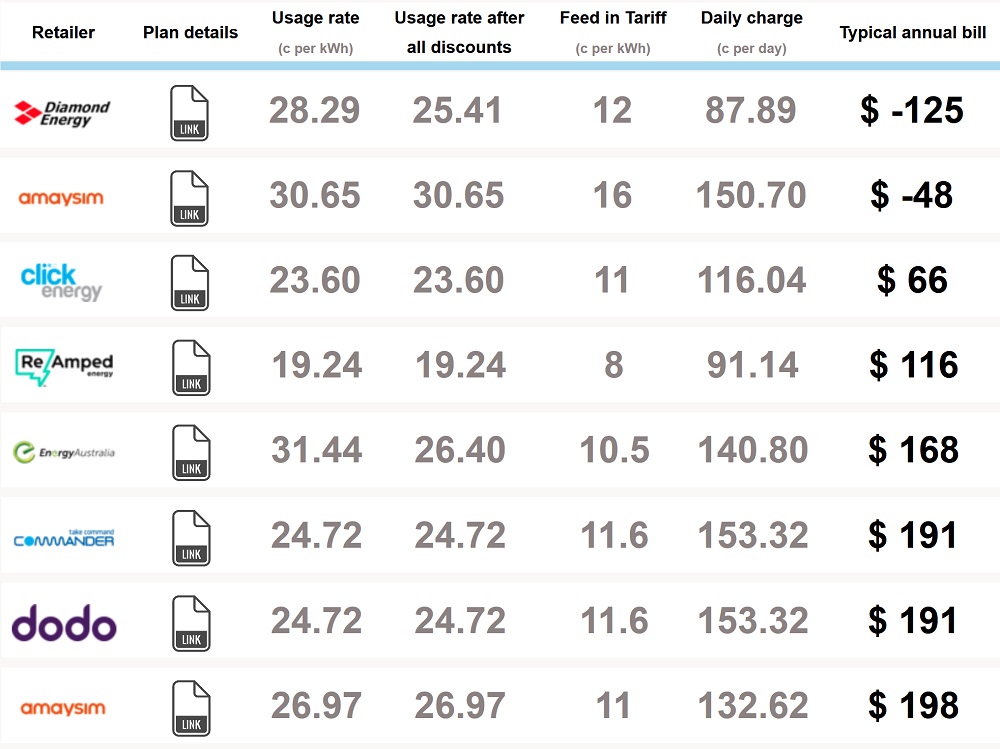
While I can’t be certain electricity prices won’t increase, I don’t consider the fixed per kilowatt-hour charge a good reason to join this plan. If you are concerned about rising electricity prices, then getting regular solar is a smart way to protect yourself.
You Can Have A Controlled Load
If you join this Solar Plus Plan scheme, you can have a controlled load, such as an off-peak electric hot water system. At the moment the charge for controlled load electricity will be 13.2 cents per kilowatt-hour, but this can change. To be eligible for the scheme you must use an average of at least 10 kilowatt-hours a day, but if you currently have a controlled load, the minimum average is 12 kilowatt-hours a day.
You Can Get One Dollar From Energy Australia
To join this VPP, you have to give Energy Australia permission to enter your property to maintain and repair the solar power and battery systems. In return for this, if you specifically request it, Energy Australia says they will pay you one dollar. I certainly wouldn’t bother to ask for that. Not unless it gave me some sort of evil glee that made me guffaw with pleasure.
A 7-Year Old Solar-Battery System Won’t Be Worth Much
How much your solar panels and Powerwall will be worth after seven years of wear and tear is difficult to estimate and will depend on your circumstances, but I’m inclined to think they won’t be worth much.
While the solar system should still have plenty of years of life left, I expect that in seven years time rooftop solar power will even cheaper and more reliable than it is now.5 But home batteries are bound to cost far less and be a hell of a lot more reliable. If home battery systems were mass-produced — like cars or microwaves or solar panels — for a growing and competitive market, then with today’s technology they’d roughly halve in cost. This means the value of a battery system more with only three years warranty remaining may not be much.
If an equivalent sized battery system can be installed for $5,000 that has three times the expected lifespan of the used Powerwall 2, then the old Powerwall’s value would be a fraction of that amount. While I don’t know what will be available in the future, I strongly suspect the value of the battery system would be considerably less than $5,000 when it becomes the household’s property after seven years.
Buying Your Own, Bigger Solar Makes More Sense
You might be thinking that even if a 7-year-old battery system won’t be worth much if it’s worth anything at all, it’s an excellent deal. After all, you will have paid nothing for it. But that’s not true. There is a real cost to this ‘free’ offer.
To make it clear how much joining Energy Australia’s VPP with $0 down actually costs you, I’ll compare the 7-year savings from joining the VPP with the 7-year savings from buying your own solar power system.
I’ll compare four different scenarios, a 6.6 kW and 8 kW solar purchase with a 10 kWh and 16 kWh daily electricity consumption. Here are the results for the impatient reader:
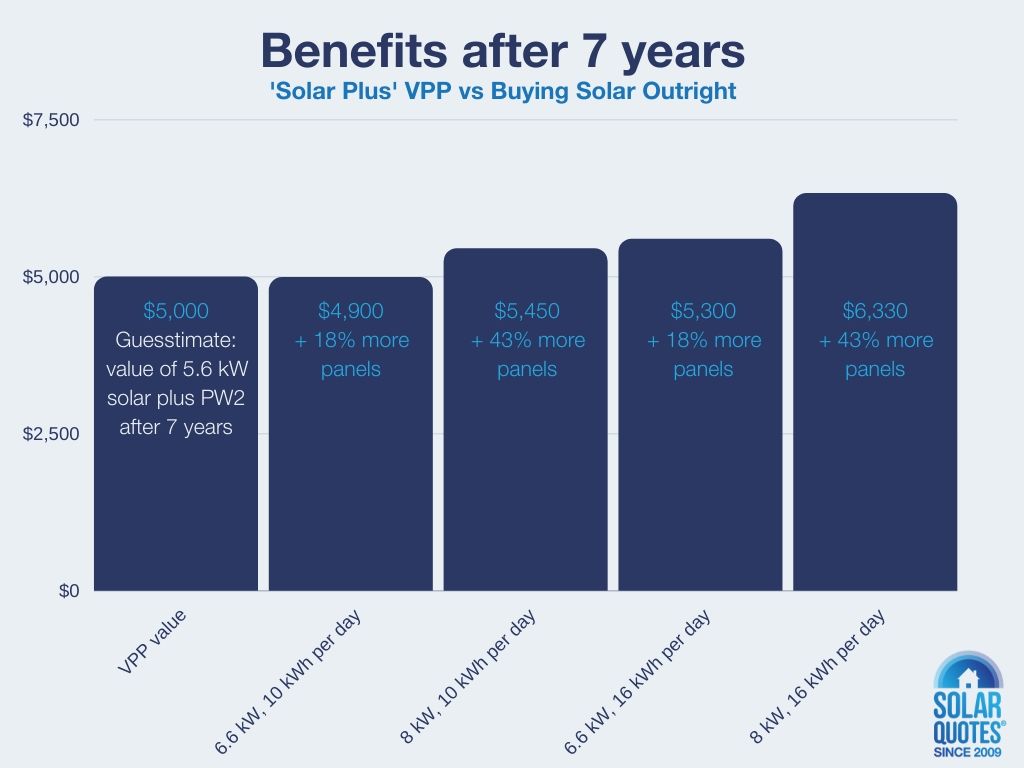
Comparing the ‘Solar Plus’ VPP with buying different sized solar power systems outright for 10 kWh per day and 16 kWh per day consumption.
Scenario #1 — VPP vs 6.6kW Solar — 10 kWh per day consumed
I’m assuming it costs $5,000 to buy 6.6 kilowatt of solar power. I’ll start with a household that consumes the minimum amount of electricity required to join the scheme — 10 kilowatt-hours per day.
With the Energy Australia Solar Plus Plan your position on day one and after 7 years on day 2,557 will be:
Day 1: $0
Day 2,557: 7 year old 5.6 kilowatt solar system plus 7 year old Tesla Powerwall 2 battery system with potentially a lot of wear and tear with a value I think will be considerably less than $5,000.
But if you buy a 6.6 kilowatt solar power system for $5,000 , then your position will be:
Day 1: -$5,000
Day 2,557: -$5,000 plus $9,900 in electricity bill savings/credit for a total benefit of nearly $5,000 plus an 18% larger solar system.
I obtained the $9,900 figure from our Solar & Battery calculator by telling it the cost of electricity was the same as for the Solar Plus Plan6 and that the solar feed-in tariff was 11 cents. If you look at the list of currently available plans above you’ll see an 11 cent feed-in tariff is not at all unreasonable at the moment.
Our Solar & Battery Calculator does include a 3% electricity price rise as a default, and electricity prices appear more likely to trend down, at least in real terms.7 So if I change that to 0% electricity price rise, then over seven years the savings come to around $9,450 putting the home a total of $4,450 ahead, along with having a larger solar power system.
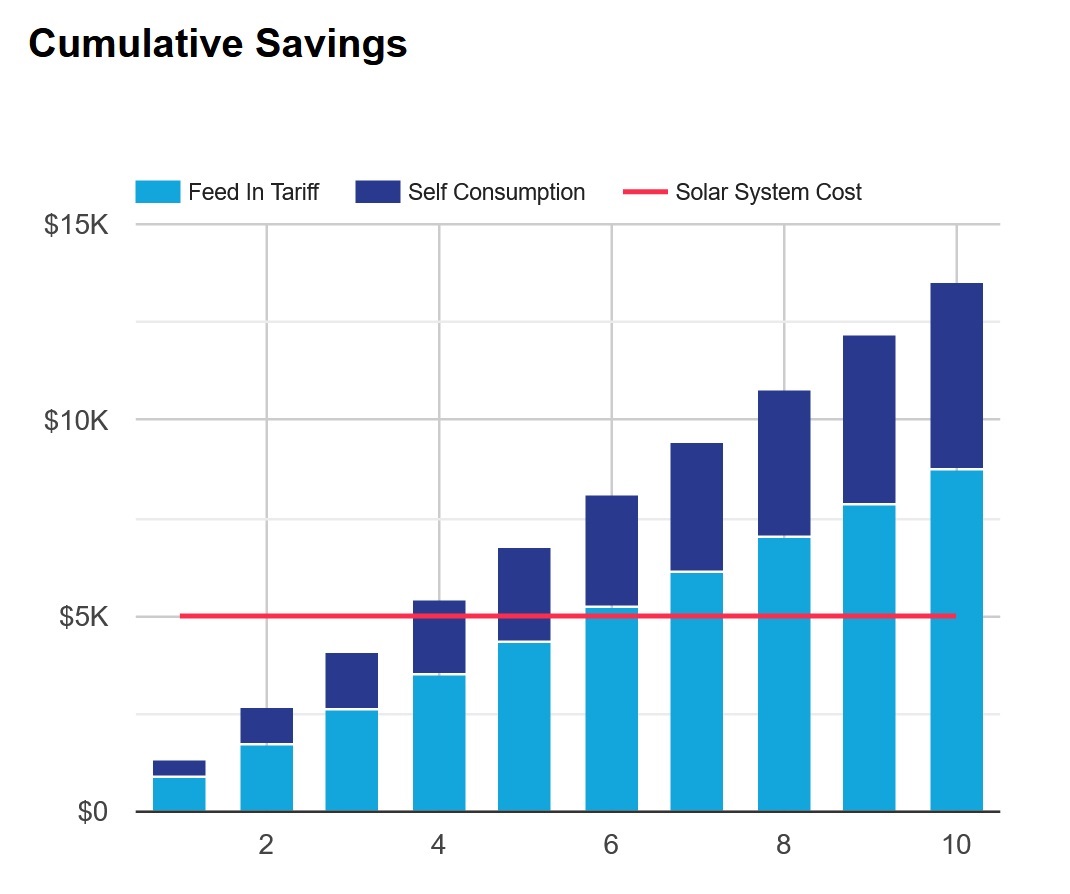
Cumulative savings from installing a 6.6 kilowatt solar system in Sydney with a grid electricity price of 26 cents and a solar feed-in tariff of 11 cents with 0% electricity price inflation.
So even if a home only uses the minimum amount of electricity required to join Energy Australia’s Solar Plus Plan VPP, buying a 6.6 kilowatt solar system looks likely to be a better alternative.
Calculation Caveats & Provisos
I used a price of $5,000 for a 6.6 kilowatts, which is not an expensive solar power system. But the Energy Australia Solar Plus Plan with Q.MAXX panels and a Goodwe inverter is a low-cost system. If you are willing to shop around, you can find a 6.6 kilowatt system with similar hardware from an installer who does good quality work for less. But I’ll stick with $5,000 because it’s a nice round number and also because under the scheme the Goodwe’s warranty has been extended to 10 years, which moderately bumps up the price.
I told the battery calculator the solar was north facing so if panels face other directions, which they often do, the returns will be slightly less.
I haven’t included the cost of a 5 year inspection for the solar system.
I also haven’t accounted for capital costs for three main reasons:
- It makes my life easier
- Over a 7 year period they won’t be large
- If the savings from solar are invested, the returns can offset the capital costs
I can’t say that returns from solar savings will equal the costs of capital, but it does stop me from feeling bad about hand waving the problem away. However, if you can’t buy a solar power system outright and have to finance it, that may add 20% to its cost. Hopefully less, as interest rates are pretty low these days. But even if it adds an extra $1,000 to the total cost, it doesn’t necessarily make getting just solar a worse alternative.
Scenario #2 — VPP vs 8 kW of Solar — 10 kWh per day consumed
Spoiler: An 8 kW Solar System Is Better
While only getting a 6.6 kilowatt system looks like a good alternative, if an 8 kilowatt solar system is installed, things are even better. Normally solar power systems cost less per kilowatt the larger they are, but I’ll assume an almost constant price per kilowatt and assume it costs $6,000 for an 8 kilowatt system. With the same assumptions as before, including 0% electricity price rise, outcomes would be:
Day 1: -$6,000
Day 2,557: -$6,000 plus approximately $11,450 in electricity bill savings/credit for a total benefit of around $5,450 plus a solar system that’s 43% larger
If we round the total benefit down to $5,000 or even knock it down to $4,000 I think that’s still better than having an old battery system with 7 years worth of wear and tear on it. On top of that, the household will also have a much larger solar system. This means if they decide to get a battery, it will have a better return as the additional solar energy generation will help keep it charged, and they’ll be in a much better position if they decide to get an electric car in the future.
Most homes in NSW have single-phase power and can only export a maximum of 5 kilowatts of solar power.8 But a solar inverter larger than 5 kilowatts can be installed if it is export limited to 5 kilowatts. While some solar energy generation can be lost by doing this, the amount is usually small, and if a modest effort is made to use electricity in the middle of the day, it will often be insignificant.
The More Electricity You Use The Worse The Scheme Gets
The more electricity a household consumes, the worse off it will be with the Energy Australia Solar Plus Plan compared to just getting a solar power system.
Scenario #3 — VPP vs 8 kW Solar — 16 kWh per day consumed
If a home uses an average of 16 kilowatt-hours a day, which comes to an annual use of 5,840 kilowatt-hours, then — using the same assumptions as above with 0% electricity price inflation — the outcome from getting a 6.6 kilowatt system would be:
Day 1: -$5,000
Day 2,557: -$5,000 plus approximately $10,680 in electricity bill savings/credit for a total benefit of over $5,600 plus an 18% larger solar system.
Scenario #4 — VPP vs 8 kW Solar — 16 kWh per day consumed
If an 8 kilowatt solar system is purchased instead:
Day 1: -$6,000
Day 2,557: -$6,000 plus approximately $12,330 in electricity bill savings/credit for a total benefit of around $6,330 plus a 43% larger solar system
So even if electricity consumption is just on the borderline for acceptance into the scheme, to me, it looks like a bad idea to me compared to just getting solar power. But if consumption averages over 10 kilowatt-hours a day it looks like a really bad idea. And if you like having the freedom to sell or rent out your home without paying an exit fee, or even just the freedom to change electricity plans, then joining the Energy Australia Solar Plus Plan VPP is probably not for you.
It’s Not Something For Nothing
While I hope I’ve done a good job explaining why buying solar is likely to leave families better off than joining this VPP, I know there are some people who are going to be seduced by the fact it’s $0 down. The thought of free stuff often breaks people’s brains and can result in them throwing caution to the wind if they think they’re getting something for nothing.
If, after considering all the pros and cons, you decide you want to join the VPP that’s fine with me. I just want everyone to be crystal clear that there are cons and I want to give a little help to anyone whose brain may have become a bit broken by the thought of getting something for free. If you are feeling tempted, three things I want you to keep in mind are:
- It’s not easier than getting solar.
- You are locked into Energy Australia’s plan for 7 years.
- You’re restricted in what you can do with your own home.
Getting Solar Power Is Easy: If you are tempted to join the scheme because you’re currently thinking…
“I’ve considered getting solar, but it’s all seems too difficult, so I’ll just join this Energy Australia VPP scheme because it seems simple and costs me nothing.”
…I’ve got some bad news for you — or good news, actually. Getting solar is no more difficult than joining this scheme. If you want, right now you can go to our home page and enter your postcode in the space at the top right, click on the answers to some questions, and we will send you three quotes. Or if that’s too complex, we can send you just one. Every installer we will put you in touch with has been vetted by us, so you can be confident they’ll do good work. For extra reassurance, it’s easy to check their reviews online.
Passing a credit check is required to join the Energy Australia Solar Plus Plan scheme, so if you can do that, I’m sure you’ll have no problem financing a solar system if that is necessary. I generally recommend getting a minimum of around 6.6 kilowatts. I think there’s a real chance you’ll end up liking solar power so much you’ll regret having only the 5.6 kilowatts the scheme installs.
And that’s basically it. If you are only getting solar, the installation won’t take long. No need to wait the 3-5 months the Solar Plus Plan requires.
Locked in for 7 years: If you get in a snit with your electricity retailer, it’s easy enough to change to another one — unless you are a member of the Energy Australia Solar Plus Plan VPP. In this case, you’ll have to pay an exit fee of thousands of dollars before you can change to a different retailer or even use a different offer from Energy Australia. Electricity prices may or may not fall — the future is not clear — but one thing we can be pretty sure about is we’re not bloody likely to fall in love with our electricity retailers. Maybe you’re 100% convinced the 7-year fixed price is a good bet, but if you are convinced your electricity retailer won’t do anything to piss you off for 7 years, then you’re a far more trusting person than I am.
You home is not your own: While you’re a member of the VPP, you’re not permitted to sell your home or even rent it out without first paying the exit fee. You may be very confident you will stay where you are long term, but sometimes things don’t work out9, and people have to move with little notice. If this happens to you, do you really want the additional cost of having to buy your way out of a VPP at what may be a difficult time? I think it’s good life advice to avoid having additional burdens like these hanging over your head.10
There Will Be Better Offers
Even if you think the solar and battery system will be worth a lot more after 7 years than I do, I don’t recommend rushing in to join this scheme. While I’ve contrasted it to only getting a solar power system, that’s not the only option.
I think that in a year, or six months, or next week, there could easily be a VPP offer that offers a better deal than this one. There could easily be a VPP available in Sydney already that is much better I’m simply not aware of because I’m only just starting deep dives into available VPP plans. So even if you like the Energy Australia Solar Plus Plan VPP, my advice is to wait and see if something better comes along. Seven years is a big commitment.
But if you are determined to join a VPP now, that’s your choice, and I’m not going to try to stop you. I just have one request:
- Do your research and join the best VPP you can find.
I’m asking this because if people join bad VPPs, then companies won’t have any incentive to offer good ones.
Also, you can tell me the results of your research. I’d much rather go talk to my horse or replay Skyrim than do the work myself.
Footnotes
- Many electric hot water systems are on controlled loads that supply them with electricity that is cheaper than the general tariff but not available at all times. It’s sometimes called off-peak hot water.
- While a Goodwe inverter will usually have a 5-year warranty, it can be extended to 10 years. As Energy Australia says all the hardware has at least 10-year warranty, I presume it will be extended that long.
- Actually, if they use the 330 watt solar panels they say they will, then 17 of them will make a 5.61 kilowatt system, but what’s 10 watts between friends?
- Note that electricity retailers can and do make misleading claims about their plans, so it is important to check you will get what they appear to offer.
- While I am certain solar will continue to fall in price, the rate at which it falls may slow. As subsidies are gradually phased out, this may cause possible rooftop solar prices to stagnate. Hopefully, significant price falls will continue.
- Actually, I rounded it down from 26.5 to 26 cents.
- If the price of something doesn’t increase in real terms, it means price rises don’t keep up with inflation. So if electricity prices just stay where they are now, they’ll be decreasing in real terms as long as we have positive inflation.
- Unfortunately, some homes are limited to exporting less than that due to limitations of the local grid.
- Trust me on this, I’ve been married three times.
- My advice for success in life is to always get good intelligence first. Normally I attempt to do this by marrying someone smarter than me.
Original Source: https://www.solarquotes.com.au/blog/energy-australia-solar-plus/







